Run the Secure Data Connector Client under Proxy Network Setup
Once a secure data connector has been created in Environment Operations Center, the client must be deployed on your local system before you can establish a connection. The default guideline on system requirements and steps to deploy a data connector client on a Windows, Linux, or Docker system are available in deploy a secure data connector client guide.
This guide covers the additional steps needed for running the client in a proxy network setup.
You must create a secure data connector endpoint in Env Ops Center before deploying on the client side. For details on how to create a secure data connector in Env Ops Center, see the add a data connector guide.
Proxy Configuration for Windows
To have secure data connector client run on a Windows system, refer the section Deploy on Windows in deploy a secure data connector client guide.
There are two options you can configure the proxy connection. First option is to open the appsettings.Production.json file and locate the proxy section, and fill in the values for respective keys.
The proxy configuration supports only simple authentication. However, if certificate-based authentication is preferred, it would need to be implemented at the system level using environment variables.
Proxy Configuration Key | Description |
|---|---|
Url | The proxy server url. |
UserName | If proxy server requires authentication, its username value. |
Password | If proxy server requires authentication, its password value. |

Second option is to set the proxy configuration at the windows operating system level by setting the system environment variables http_proxy and https_proxy.
The values for these variables can be of following formats:
- http://{username}:{password}@{proxy_server_ip}:{proxy_server_port}
- https://{username}:{password}@{proxy_server_ip}:{proxy_server_port}
Placeholder | Description |
|---|---|
username | Proxy server credential, username value. |
password | Proxy server credential, password value. |
proxy_server_ip | The proxy server IP. |
proxy_server_port | The proxy server port. |
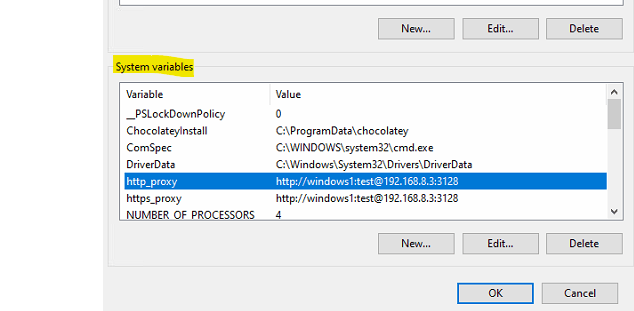
Once you have the proxy configuration setup, go back to Deploy on Windows section in deploy a secure data connector client guide and follow the next steps.
Proxy Configuration for Linux
To have secure data connector client run on a Linux system, refer the section Deploy on Linux in deploy a secure data connector client guide.
There are two options you can configure the proxy connection. First option is to open the appsettings.Production.json file and locate the proxy section, and fill in the values for respective keys.
The proxy configuration supports only simple authentication. However, if certificate-based authentication is preferred, it would need to be implemented at the system level using environment variables.
Proxy Configuration Key | Description |
|---|---|
Url | The proxy server url. |
UserName | If proxy server requires authentication, its username value. |
Password | If proxy server requires authentication, its password value. |

Second option is to set the proxy configuration at the linux operating system level by setting the environment variable https_proxy.
The values for this variable can be of following formats:
- http://{username}:{password}@{proxy_server_ip}:{proxy_server_port}
- https://{username}:{password}@{proxy_server_ip}:{proxy_server_port}
Placeholder | Description |
|---|---|
username | Proxy server credential, username value. |
password | Proxy server credential, password value. |
proxy_server_ip | The proxy server IP. |
proxy_server_port | The proxy server port. |
The value is set using the command:
export https_proxy=http://linux1:[email protected]
Once you have the proxy configuration setup, go back to Deploy on Linux section in deploy a secure data connector client guide and follow the next steps.
Proxy Configuration for Docker
To have secure data connector client run on a Linux system, refer the section Deploy on Docker in deploy a secure data connector client guide.
There are two options to configure the proxy for Docker. First option is to set the proxy configuration at each containers by passing values for the environment variables while running the docker command.
docker run -e "ServerHubConfiguration__AgentToken=[access_token]" -e "ServerHubConfiguration__Proxy__Url=http://192.168.8.3:3128" -e "ServerHubConfiguration__Proxy__UserName=ProxyUs3r" -e "ServerHubConfiguration__Proxy__Password=$Pa$$word!" -e HTTP_PROXY="http://ProxyUs3r:[email protected]:3128" -e HTTPS_PROXY="http://ProxyUs3r:[email protected]:3128" radiantone/sdc-client:latest
The second option is to set the proxy configuration at the docker engine as shown below.

When proxy configuration is set at the docker engine, the secure data connector client can be run as normal:
docker run -e "ServerHubConfiguration_AgentToken=[access_token]" radiantone/sdc-client
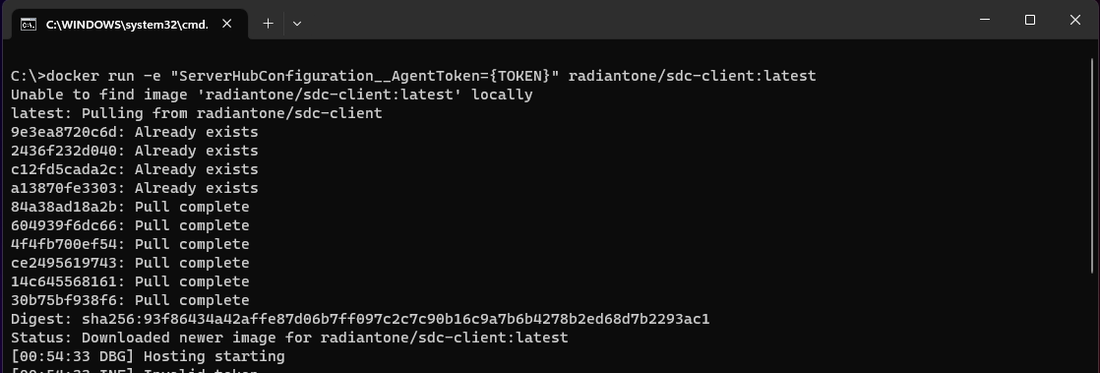
It is highly recommended to have logs from sdc-client to go into a mounted drive, to have that setup replace the above commands with the one below based on one of the options you chose for your deployment:
Option 1 (Passing proxy information as part of environment variables):
docker run -v /path/on/host:/app/logs -e "ServerHubConfiguration__AgentToken=[access_token]" -e "ServerHubConfiguration__Proxy__Url=http://192.168.8.3:3128" -e "ServerHubConfiguration__Proxy__UserName=ProxyUs3r" -e "ServerHubConfiguration__Proxy__Password=$Pa$$word!" -e HTTP_PROXY="http://ProxyUs3r:[email protected]:3128" -e HTTPS_PROXY="http://ProxyUs3r:[email protected]:3128" radiantone/sdc-client:latest
Option 2 (Making changes at docker engine level):
docker run -v /path/on/host:/app/logs -e "ServerHubConfiguration_AgentToken=[access_token]" radiantone/sdc-client
Replace /path/on/host with an actual path on your host machine where you want to store the logs.
Once the client is running, you can can set up a connection with the on-premise backend. For details on setting up a connection, see the Data Sources guide.
Deploy the Secure Data Connector Client
Once a secure data connector has been created in Environment Operations Center, the client must be deployed on your local system before you can establish a connection. This guide outlines the system requirements and steps to deploy a data connector client on a Windows, Linux, or Docker system.
You must create a secure data connector endpoint in Env Ops Center before deploying on the client side. For details on how to create a secure data connector in Env Ops Center, see the add a data connector guide.
System requirements
The following system specifications are required to deploy the secure data connector client. Please ensure your system meets these requirements before proceeding to the deployment steps below.
System requirements:
- .NET core runtime must be installed on the machine or SDK (version 8 and above). The runtime is available on the Microsoft .NET page.
- CPU: x-64 processor
- Processor: 1 GHz
- RAM 512 MB
- Minimum disc space (64-bit): 4.5 GB
- Operation System: Windows Server 2016 Datacenter, Windows Server 2019 Datacenter, Windows Server 2022 Datacenter, AWS Linux 2, Ubuntu 20.04.6 LTS, Red Hat Enterprise Linux 8.8, and Debian GNU/Linux 12.
- Ensure wildcard searches for "radiantlogic.io" are whitelisted for outbound network connections, including any specific network firewalls configured for WSS protocol.
Getting started
Before deploying the secure data connector client, you must retrieve the registration token associated with the data connector in Env Ops Center. For Windows or Linux systems, you must also download the respective binary.
To locate these dependencies in Env Ops Center, select the connector name to open the connector details. Alternatively, you can also select View Details from the Options (...) dropdown menu to open the connector details.
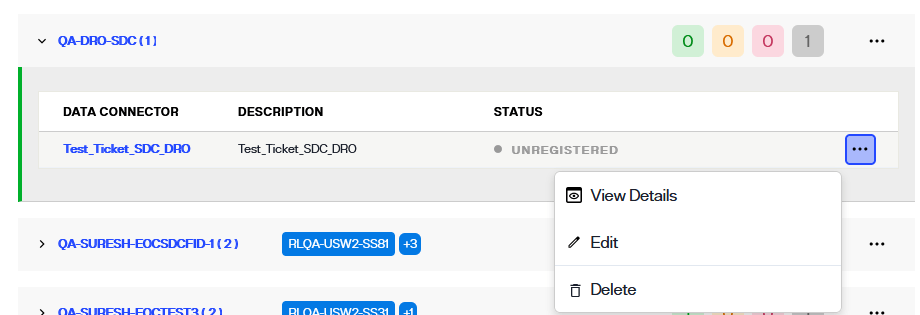
In the Data Connector Info section the connector status displays as "Unregistered", and there are no available connections.
Next to the status in the Data Connector Info section select Register.
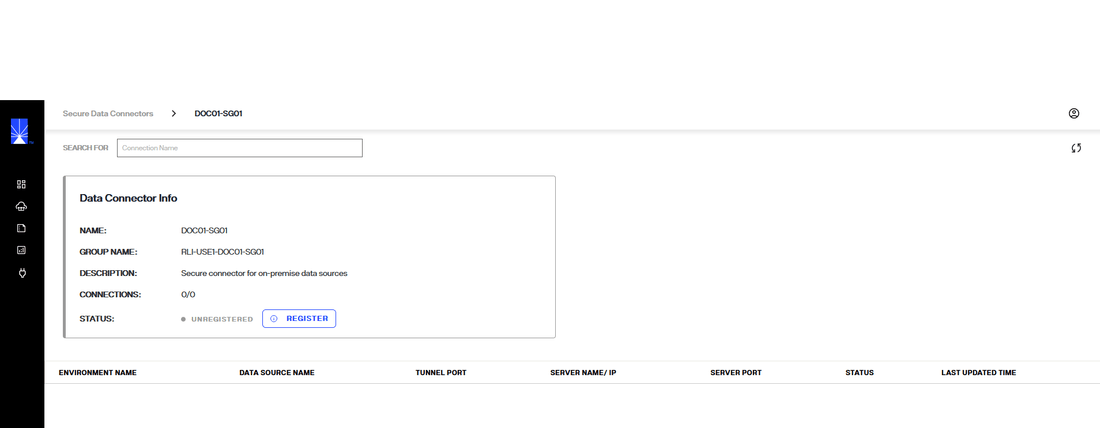
For Windows or Linux systems, select the applicable card to download the binary.
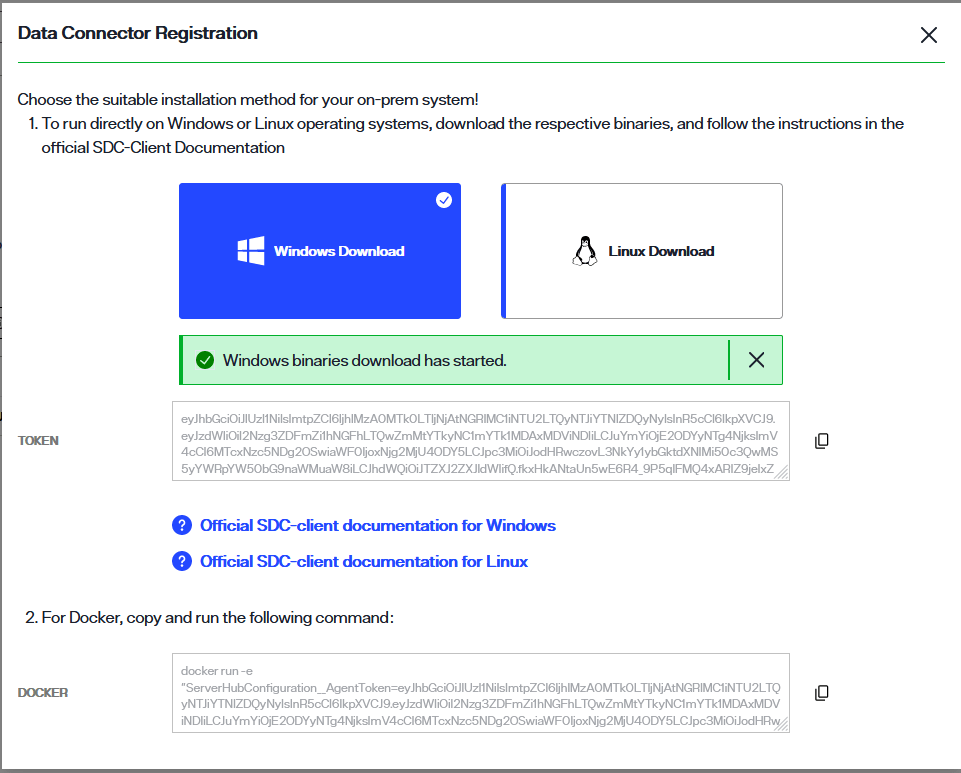
A confirmation message displays once the binary has successfully downloaded.
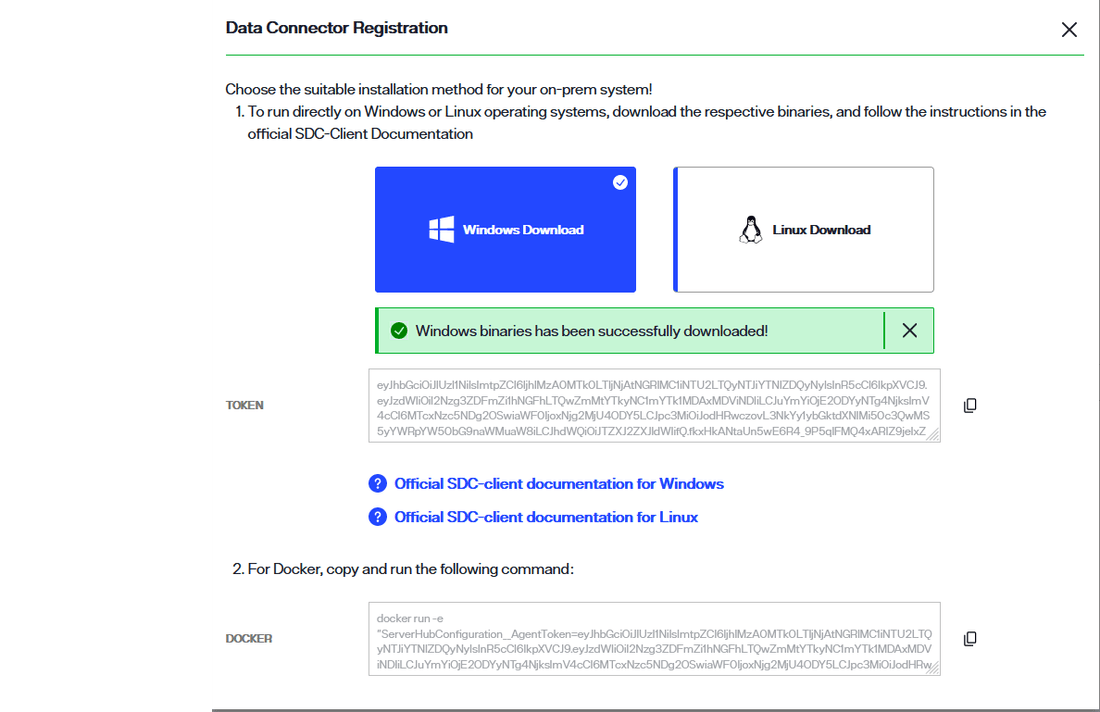
Select the copy icon to copy the registration token located just below the Windows and Linux cards. You will use this while deploying the secure data connector client. The steps to deploy a secure data connector on a Windows or Linux system are outlined in the following sections.
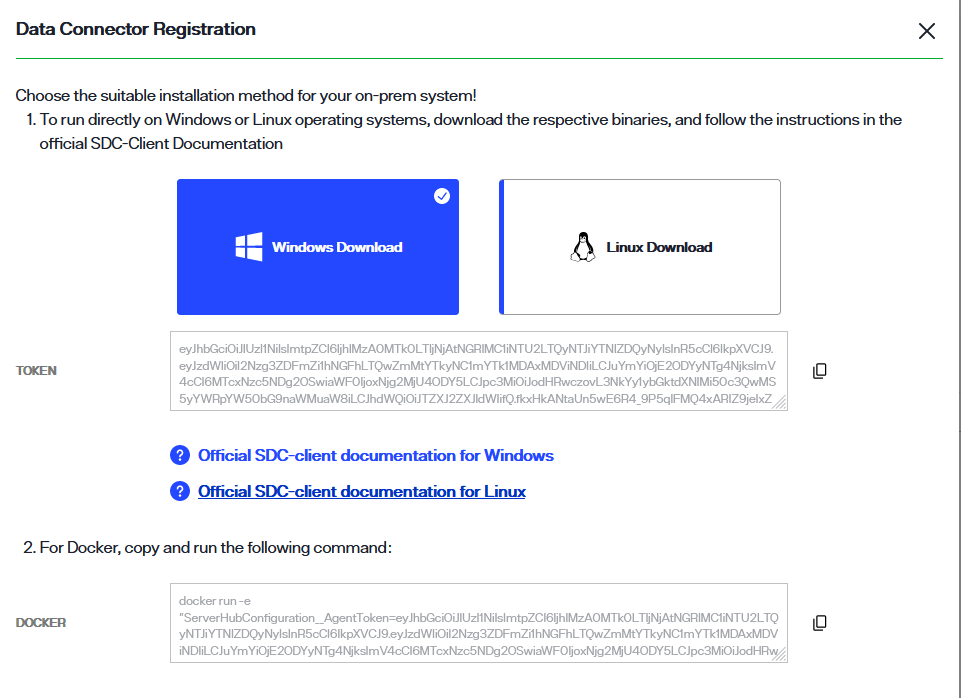
For a Docker container, copy the docker command located in the Docker section of the Data Connector Registration dialog. You will use this while deploying the secure data connector client on the Docker container. The steps to deploy a secure data connector on a Docker container are outlined in the following sections.
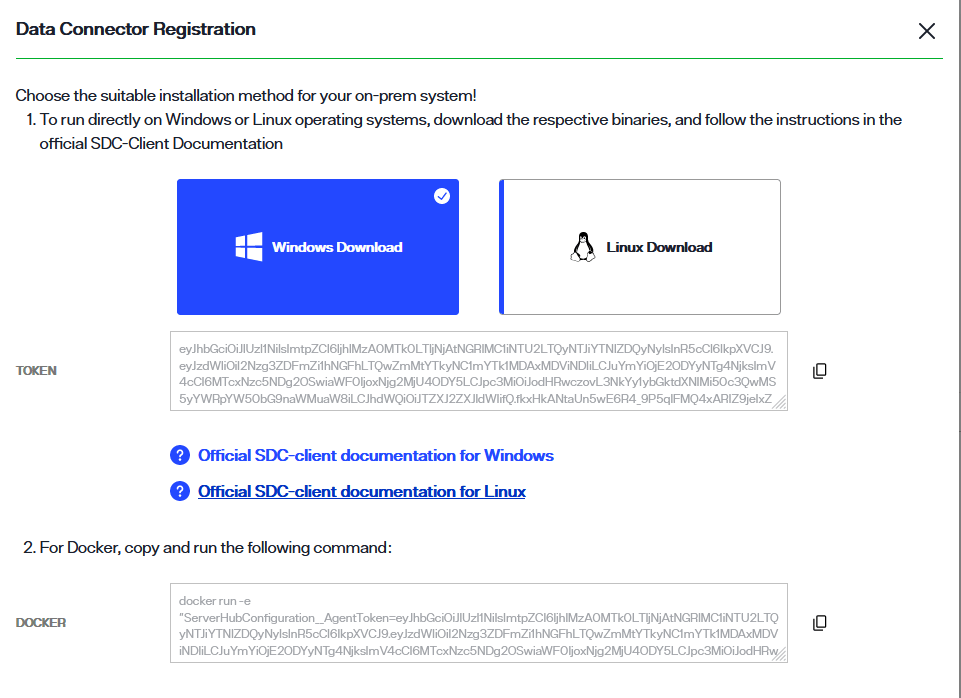
Deploy on Windows
To deploy the secure data connector client on a Windows system, first unzip the sdc-windows-(version).zip file into a directory on the client system. Next, locate the following files:
- appsettings.Production.json
- RadiantLogic.OnPremisesAgentClient.Agent.exe
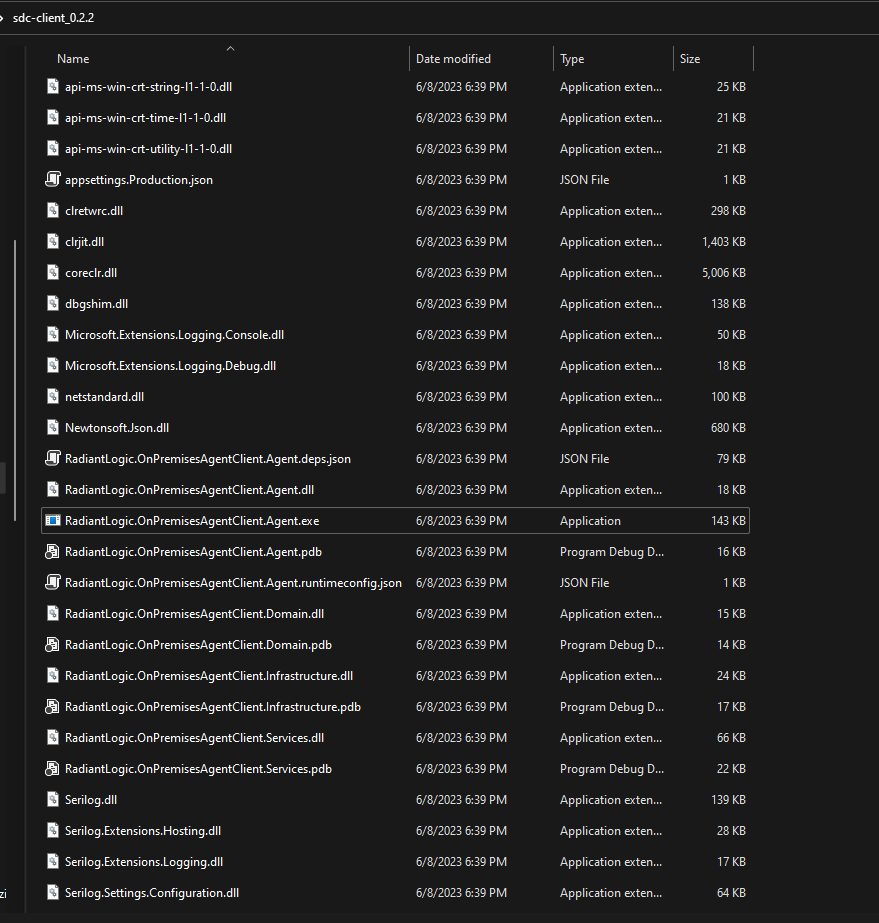
Open the appsettings.Production.json file and locate the "AgentToken" field. Enter the token copied from the Data Connector Registration dialog in Env Ops Center into the "AgentToken" field.

If the client to be run on a network where proxy is setup, see the Proxy Configuration for Windows section. Once you have the proxy settings updated following instructions in proxy configuration guide, continue to the next steps.
Launch the RadiantLogic.OnPremisesAgentClient.Agent.exe file. A notification displays in the command line that confirms a connection has been established between the agent and server.

Once the client is running, you can can setup a connection with the on-premise backend. For details on setting up a connection, see the Data Sources guide.
Deploy as a service on Windows
Step 1: Launch Command window as Administrator (Run as administrator)
Step 2: Create the service using following commands
sc create <ServiceName> binPath= "<PathToExecutable> --service”

Step 3: Configure the service to start automatically (Optional)
sc config <ServiceName> start= auto

Step 4: Start the service
sc start <ServiceName>

Following all the above steps, your sdc-client should be registered to run as a Windows service and started automatically.

Deploy on Linux
To deploy the secure data connector client on a Linux system, first unzip the sdc-linux-(version).zip file into a directory on the client system. Next, locate the following files:
- appsettings.Production.json
- RadiantLogic.OnPremisesAgentClient.Agent
Open the appsettings.Production.json file using an editor and locate the "AgentToken" field. Enter the token copied from the Data Connector Registration dialog in Env Ops Center into the "AgentToken" field.
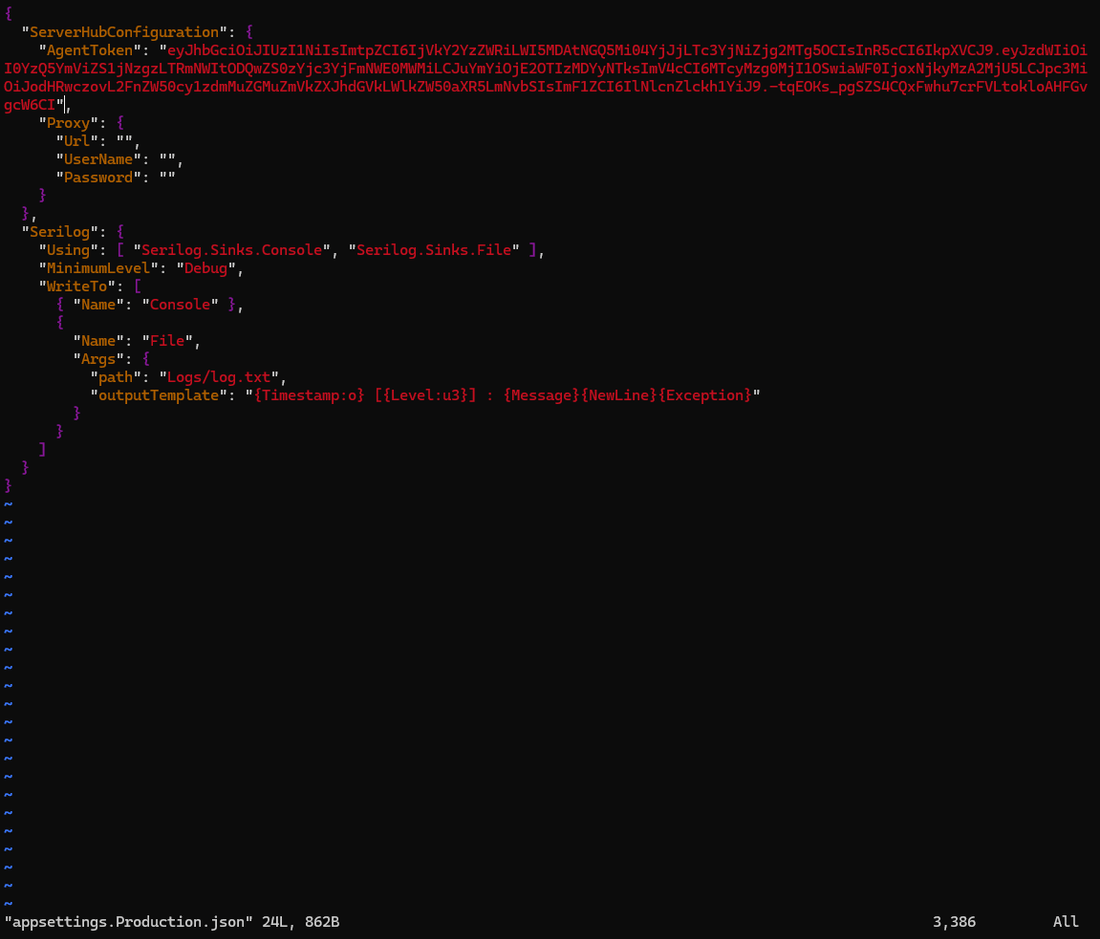
If the client to be run on a network where proxy is setup, see the Proxy Configuration for Linux section in run the secure data connector client under proxy network setup guide. Once you have the proxy settings updated following instructions in proxy configuration guide, continue to the next steps.
Open the command line and navigate to the directory that contains the unzipped sdc-linux.zip files. From the directory, run the following command to give execute permissions for inlets-pro and RadiantLogic.OnPremisesAgentClient.Agent:
chmod +x ./RadiantLogic.OnPremisesAgentClient.Agent
chmod +x ./inlets-pro
Then launch the secure data connector client using this command:
./RadiantLogic.OnPremisesAgentClient.Agent
A notification displays in the command line that confirms a connection has been established between the agent and server.
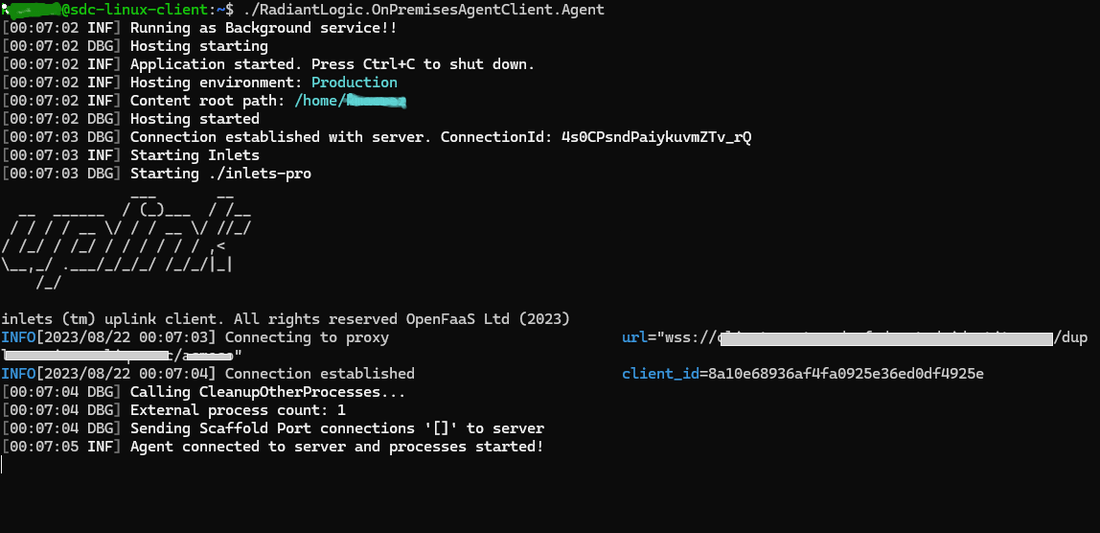
Once the client is running, you can can setup a connection with the on-premise backend. For details on setting up a connection, see the Data Sources guide.
Deploy as a daemon on Linux
Step 1: CD to binary location and give execute permissions for inlets-pro and RadiantLogic.OnPremisesAgentClient.Agent
chmod +x ./RadiantLogic.OnPremisesAgentClient.Agent
chmod +x ./inlets-pro

Step 2: Check the Init System:
Determine which init system your Linux distribution uses. Common init systems include systemd, SysV init, and Upstart. You can often identify the init system by checking the version of Linux or the documentation for your specific distribution. Steps 3.1 and 3.2 covers the cases of systemd and SysV Init.
Step 3.1: If your system use 'systemd'. Follow below steps:
Create a Systemd Service File:
Create a .service file in the /etc/systemd/system/ directory. This file defines the configuration for our application daemon. Replace ‘your-app-name’ with an appropriate name for SDC Client:
sudo nano /etc/systemd/system/your-app-name.service
Edit the Service File:
In the nano editor, add the following content to the service file, adjusting the paths and parameters to match your environment:
[Unit]
Description=Give your description here for running SDC Client as Daemon
Wants=network-online.target
After=network-online.target
[Service]
WorkingDirectory=/path/to/binary/sdc-client
ExecStart=/path/to/binary/sdc-client/RadiantLogic.OnPremisesAgentClient.Agent
Restart=always
RestartSec=10
SyslogIdentifier=your-app-name
User=your-username
Environment=ASPNETCORE_ENVIRONMENT=Production
[Install]
WantedBy=multi-user.target

-
WorkingDirectory: Set this to the directory where your downloaded binaries is located.
-
ExecStart: Specify the path to executable and the path to application's DLL.
-
User: Replace your-username with the appropriate username that should run the application.
Reload Systemd and Start the Service:
After creating and editing the service file, reload the systemd configuration and start the application:
sudo systemctl daemon-reload
sudo systemctl start your-app-name

Enable Autostart on Boot:
To make sure your application starts automatically when the system boots, enable the service:
sudo systemctl enable your-app-name
To validate the sdc client is successfully started as a service, you can check the client logs in the /Logs folder and opening the log file:

Manage the Service:
You can use standard systemd commands to manage your application daemon:
-
Start:
sudo systemctl start your-app-name -
Stop:
sudo systemctl stop your-app-name -
Restart:
sudo systemctl restart your-app-name -
Check status:
sudo systemctl status your-app-name -
Disable autostart:
sudo systemctl disable your-app-name
Note: Remember to replace placeholders like your-app-name, /path/to/binary/sdc-client, and your-username with actual values.
Step 3.2: If your system use 'SysV init'. Follow below steps:
Create a new init script file, replacing your-app-name and adjusting paths:
sudo nano /etc/init.d/your-app-name
Add the following content to the file:
#!/bin/bash
### BEGIN INIT INFO
# Provides: your-app-name
# Required-Start: $local_fs $network
# Required-Stop: $local_fs $network
# Default-Start: 2 3 4 5
# Default-Stop: 0 1 6
# Short-Description: Give your description here for running SDC Client as Daemon
# Description: Give your detailed description here for running SDC Client as Daemon
### END INIT INFO
case "$1" in
start)
cd /path/to/binary/sdc-client
sudo -u your-username RadiantLogic.OnPremisesAgentClient.Agent &
;;
stop)
pkill -f "RadiantLogic.OnPremisesAgentClient.Agent"
;;
restart)
$0 stop
$0 start
;;
*)
echo "Usage: $0 {start|stop|restart}"
exit 1
;;
esac
exit 0
Save the file and make it executable:
sudo chmod +x /etc/init.d/your-app-name
Start and Manage the Service:
Use the following commands to start, stop, and restart your application:
Start: sudo /etc/init.d/your-app-name start Stop: sudo /etc/init.d/your-app-name stop Restart: sudo /etc/init.d/your-app-name restart
Enable Autostart on Boot:
If your init system supports it, you might be able to enable the script to start automatically on boot:
sudo update-rc.d your-app-name defaults
Note: Remember to replace placeholders like your-app-name, /path/to/binary/sdc-client, and your-username with actual values.
Deploy on Docker
To deploy the secure data connector client on Docker, Docker must first be installed on the system. If you have not yet installed Docker, please visit the Docker site and follow the instructions to download and install.
Open the command line and run the copied command from Env Ops Center to start the client:
docker run -e "ServerHubConfiguration_AgentToken=[access_token]" radiantone/sdc-client
It is highly recommended to have logs from sdc-client to go into a mounted drive, to have that setup replace the above command with the one below:
docker run -v /path/on/host:/app/logs -e "ServerHubConfiguration_AgentToken=[access_token]" radiantone/sdc-client
Replace /path/on/host with an actual path on your host machine where you want to store the logs.
If the client to be run on a network where proxy is setup, see Proxy Configuration for Docker.
The radiantone/sdc-client is the latest image of the secure data connector client container located in the Radiant Logic Docker Hub repository.

Once the client is running, you can can setup a connection with the on-premise backend. For details on setting up a connection, see the Data Sources guide.